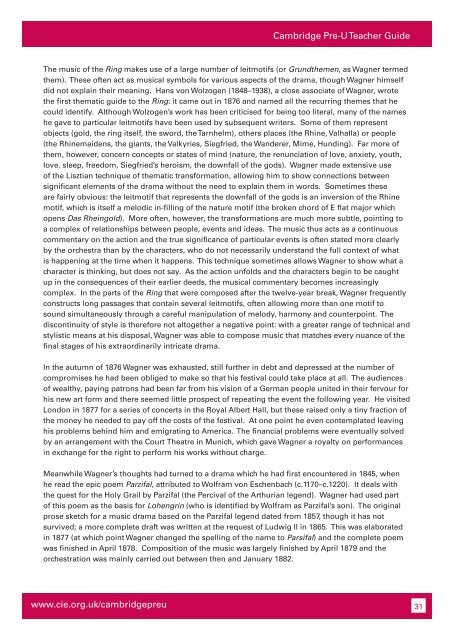Teacher's Guide Cambridge Pre-U MUSIC Available for teaching ...
Teacher's Guide Cambridge Pre-U MUSIC Available for teaching ...
Teacher's Guide Cambridge Pre-U MUSIC Available for teaching ...
You also want an ePaper? Increase the reach of your titles
YUMPU automatically turns print PDFs into web optimized ePapers that Google loves.
<strong>Cambridge</strong> <strong>Pre</strong>-U Teacher <strong>Guide</strong><br />
The music of the Ring makes use of a large number of leitmotifs (or Grundthemen, as Wagner termed<br />
them). These often act as musical symbols <strong>for</strong> various aspects of the drama, though Wagner himself<br />
did not explain their meaning. Hans von Wolzogen (1848–1938), a close associate of Wagner, wrote<br />
the first thematic guide to the Ring: it came out in 1876 and named all the recurring themes that he<br />
could identify. Although Wolzogen’s work has been criticised <strong>for</strong> being too literal, many of the names<br />
he gave to particular leitmotifs have been used by subsequent writers. Some of them represent<br />
objects (gold, the ring itself, the sword, the Tarnhelm), others places (the Rhine, Valhalla) or people<br />
(the Rhinemaidens, the giants, the Valkyries, Siegfried, the Wanderer, Mime, Hunding). Far more of<br />
them, however, concern concepts or states of mind (nature, the renunciation of love, anxiety, youth,<br />
love, sleep, freedom, Siegfried’s heroism, the downfall of the gods). Wagner made extensive use<br />
of the Lisztian technique of thematic trans<strong>for</strong>mation, allowing him to show connections between<br />
significant elements of the drama without the need to explain them in words. Sometimes these<br />
are fairly obvious: the leitmotif that represents the downfall of the gods is an inversion of the Rhine<br />
motif, which is itself a melodic in-filling of the nature motif (the broken chord of E flat major which<br />
opens Das Rheingold). More often, however, the trans<strong>for</strong>mations are much more subtle, pointing to<br />
a complex of relationships between people, events and ideas. The music thus acts as a continuous<br />
commentary on the action and the true significance of particular events is often stated more clearly<br />
by the orchestra than by the characters, who do not necessarily understand the full context of what<br />
is happening at the time when it happens. This technique sometimes allows Wagner to show what a<br />
character is thinking, but does not say. As the action unfolds and the characters begin to be caught<br />
up in the consequences of their earlier deeds, the musical commentary becomes increasingly<br />
complex. In the parts of the Ring that were composed after the twelve-year break, Wagner frequently<br />
constructs long passages that contain several leitmotifs, often allowing more than one motif to<br />
sound simultaneously through a careful manipulation of melody, harmony and counterpoint. The<br />
discontinuity of style is there<strong>for</strong>e not altogether a negative point: with a greater range of technical and<br />
stylistic means at his disposal, Wagner was able to compose music that matches every nuance of the<br />
final stages of his extraordinarily intricate drama.<br />
In the autumn of 1876 Wagner was exhausted, still further in debt and depressed at the number of<br />
compromises he had been obliged to make so that his festival could take place at all. The audiences<br />
of wealthy, paying patrons had been far from his vision of a German people united in their fervour <strong>for</strong><br />
his new art <strong>for</strong>m and there seemed little prospect of repeating the event the following year. He visited<br />
London in 1877 <strong>for</strong> a series of concerts in the Royal Albert Hall, but these raised only a tiny fraction of<br />
the money he needed to pay off the costs of the festival. At one point he even contemplated leaving<br />
his problems behind him and emigrating to America. The financial problems were eventually solved<br />
by an arrangement with the Court Theatre in Munich, which gave Wagner a royalty on per<strong>for</strong>mances<br />
in exchange <strong>for</strong> the right to per<strong>for</strong>m his works without charge.<br />
Meanwhile Wagner’s thoughts had turned to a drama which he had first encountered in 1845, when<br />
he read the epic poem Parzifal, attributed to Wolfram von Eschenbach (c.1170–c.1220). It deals with<br />
the quest <strong>for</strong> the Holy Grail by Parzifal (the Percival of the Arthurian legend). Wagner had used part<br />
of this poem as the basis <strong>for</strong> Lohengrin (who is identified by Wolfram as Parzifal’s son). The original<br />
prose sketch <strong>for</strong> a music drama based on the Parzifal legend dated from 1857, though it has not<br />
survived; a more complete draft was written at the request of Ludwig II in 1865. This was elaborated<br />
in 1877 (at which point Wagner changed the spelling of the name to Parsifal) and the complete poem<br />
was finished in April 1878. Composition of the music was largely finished by April 1879 and the<br />
orchestration was mainly carried out between then and January 1882.<br />
www.cie.org.uk/cambridgepreu 31
















